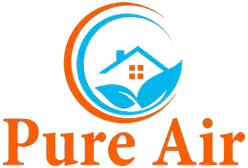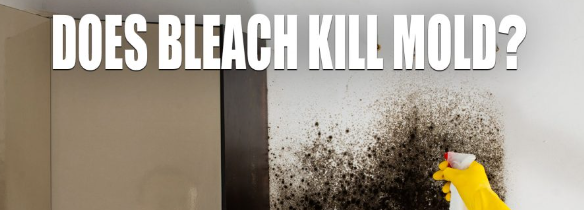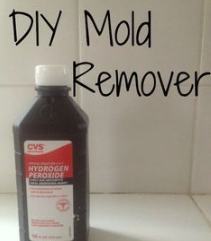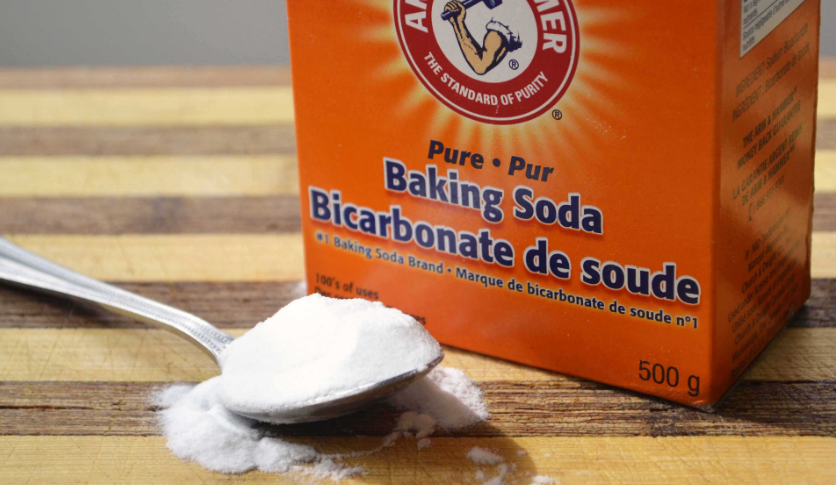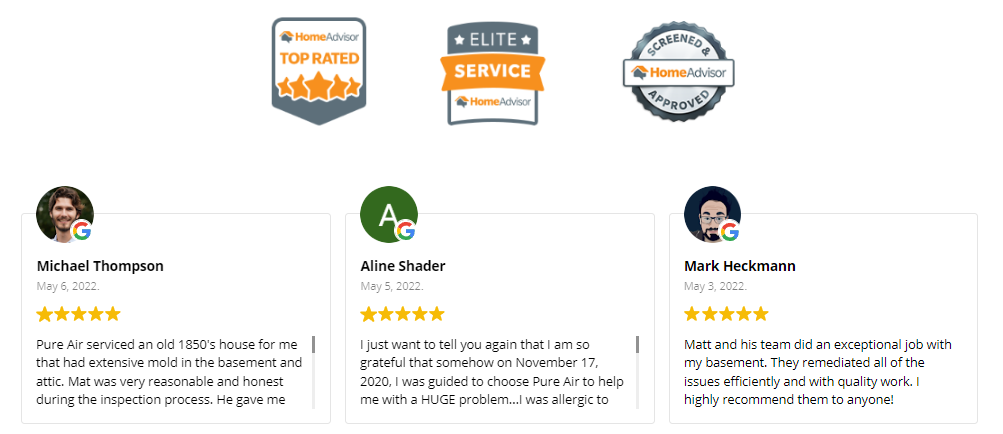Mold Removal: Do Bleach and Peroxide Kill Mold?
Yes, in most cases household bleach and Hydrogen Peroxide can kill mold. Prolonged exposure to mold inside homes can cause serious health problems to immune-compromised persons, especially elders and children if undetected and not addressed immediately. Allergic reactions are also common problems or signs of in-home mold infestations. Some products used for killing mold
- household bleach
- chlorine bleach
- vinegar (white vinegar)
- borax
- ammonia
- detergent
- baking soda
- grapefruit see extract
- tea tree oil
- hydrogen peroxide
Can bleach kill mold? Yes, but mold needs to be identified early and contained to a small area in order to be treated by the products above. Identifying sources of moisture and eliminating excess humidity can be your greatest allies.
You can do mold removal yourself if mold growth is less than 10 square feet and is non-toxic. However, if the mold problem is serious, it is better to call a professional mold remediation service company. Pure Air Nation is a mold remediation professional in the Pittsburgh area with the industry’s longest warranty and offers FREE inspections.
Keep reading to get your questions answered like can bleach kill mold and is treating mold with bleach effective? We cover porous and non porous surfaces and finally answer all.
Treating Mold with Bleach. Can Bleach Kill Surface Mold on Porous Surfaces?
Bleach can kill mold and indoor mold spores on a porous surface while leaving the surface sanitized and resistant to future mold outbreaks. However, it is only effective at killing mold on non-porous materials like glass, countertops, tiles, etc.
Bleach is not effective enough to eliminate mold growing on porous material and surfaces such as drywall and wood, as it cannot penetrate under these surfaces. Bleach will kill mold above the surfaces but cannot kill mold beneath such surfaces, which will cause the mold to return soon and leaving you in a cleaning mold time loop.
Bleach is a harsh, corrosive chemical that damages the materials on which it is used. A bleach solution gives off harsh, dangerous fumes (often chlorine gas) and, when mixed with ammonia, even produces toxic gases. US Environmental Protection Agency does not approve bleach as it harms the lungs. The cleaning products that are safer alternatives to bleach which do not produce toxic fumes, are hydrogen peroxide, white vinegar, and borax.
Bleach to Kill Mold and Mold Spores
It is essential to keep the area well-ventilated before beginning to kill mold using bleach, as it produces harsh fumes, and should always start the process by wearing gloves to protect your hands. If you have ventilation fans then please use them!
- Start by adding bleach to the water in a ratio of 1:10, i.e., the bleach added per gallon of water should be one to one and a half cups. This diluted bleach solution makes it safer but still effective for active mold growth treatment.
- You must apply the bleach solution to nonporous mold-affected surfaces using a spray bottle. You can even use a bucket and sponge if treating area rugs or other contained materials.
- Unless the surface is used for food preparation or can be touched by children, you must avoid rinsing the surface afterward, as it will inhibit mold growth in the future. A good air dry is what the doctor ordered.
Treating Mold with Hydrogen Peroxide
Hydrogen peroxide is safer alternative than using bleach to kill mold because hydrogen peroxide does not produce toxic fumes like chlorine bleach, leave any toxic residue, or cause any environmental damage. Thus, peroxide is a good alternative to chlorine bleach. In addition, hydrogen peroxide is anti-fungal, anti-bacterial and anti-viral which makes it great for heavy traffic areas and mold cleanup.
Hydrogen peroxide kills mold on
- porous surfaces
- kitchen appliances
- floors
- walls
- bathroom fixtures
- area rugs
- clothes
In addition, peroxide can help fade mold stains as it is considered a bleaching agent.
We recommend you spot test hydrogen peroxide on the material or clothing to ensure that it does not fade the material’s original color. You can buy a bottle of hydrogen peroxide of 3% concentration from a nearby drug store or wherever cleaning solutions are sold.
Killing Mold Using Hydrogen Peroxide
Here are five basic steps to using hydrogen peroxide kill mold:
- First, pour a 3% concentration of hydrogen peroxide into a spray-type bottle.
- Next, spray the mold-affected surfaces so moldy areas are saturated with hydrogen peroxide.
- Leave the moldy area for around 10-15 minutes so that hydrogen peroxide can kill the mold. Then, wait until hydrogen peroxide stops bubbling and give it another 5-10 minutes.
- Scrub the surface mold area to remove mold and mold stains. A stiff brush is often handy here.
- At last, wipe to remove spores and residual mold from the moldy surface completely before letting the area air dry.
Hydrogen peroxide reacts as it releases oxygen rapidly, which oxidizes the mold surface and decomposes it. Vinegar can also be combined to remove mold effectively. However, you must ensure that the spray bottle is kept in the dark as sunlight diminishes the effectiveness of hydrogen peroxide.
How Can I Kill Mold?
The first step to killing mold is to identify the source in order to eliminate and remove mold completely. Various products can kill mold, such as
- diluted bleach solution
- mix bleach with water
- vinegar
- borax
- ammonia
- detergent
- baking soda
- grapefruit seed extract
- tea tree oil
- hydrogen peroxide
First, the products should be used with water to create a solution in an appropriate (and safe) ratio, and then the same solution should be sprayed on the mold surface. If you have personal protective equipment, please wear personal protective equipment!
Safer Alternatives for Mold Removal
Bleach can kill mold on hard nonporous surfaces, but it cannot be used for porous materials as it cannot penetrate deep inside such surfaces. Due to its effervescent nature, hydrogen peroxide is considered a much better solution for removing mold on porous surfaces.
Besides a bleach solution and hydrogen peroxide, other mold killers are borax, vinegar, ammonia, baking soda, detergent, tea tree oil, and grapefruit seed extract.
Killing Mold with Borax
Borax is a natural cleaning product and does not emit toxic fumes or chemicals. However, Borax is toxic if swallowed. Borax is a natural mold inhibitor. However, it must be combined with water to remove and kill mold.
- First, create a borax-water solution by adding one borax cup per gallon of water.
- Use equipment like a HEPA filtered vacuum cleaner to vacuum and lessen the loose mold spores stirred up into the air during the cleaning process.
- Scrub the mold from the surface using the scrubbing brush and borax-water solution.
- Wipe off excess moisture and extra mold particles to prevent advancing into the air.
- When finished, do not rinse the borax-water solution.
- Leave the solution applied surface for some time to dry.
Vinegar to Remove Mold
Vinegar is a safe, natural mild acid that can kill 82 percent of mold species. Moreover, it does not give off toxic, dangerous fumes; and the US EPA approves it. You can use vinegar to remove all the mold by spraying it over the surface and leaving it. It would be helpful to repeat the process every few days to ensure that the surface is mold-free.
- Pour vinegar liquid into a spray bottle and ensure it is not watered down.
- Spray vinegar on the mold surface.
- Leave it for an hour.
- Finally, wipe off the area and allow it to dry.
How to Get Rid of Mold Using Ammonia
Ammonia is very similar to bleach and can kill mold on hard nonporous surfaces such as glass, countertops, and tiles. However, it is ineffective at killing mold on porous materials and surfaces such as drywall and wood. Ammonia kills the surface mold, but dead mold spores and dead mold are still allergenic, so they must be removed. If mold is on nonporous surfaces here are steps to treat with Ammonia:
- First, create a solution with 50% water and 50% clear ammonia in a spray bottle. The ammonia should have a “clear ammonia” label.
- Spray the ammonia-water solution on the moldy area.
- Leave the surface area for a few hours and then wipe it.
How to Kill Mold with Detergent and Water
By scrubbing, you can clean off the mold on non-porous surfaces using a mixture of warm water and detergent. Avoid drain cleaners but regular detergent is worth a try before using bleach to kill mold.
Mold Removal with Baking Soda
Baking soda is mild, harmless, natural, and a safe household cleaner that is effective at killing mold. Moreover, it can kill different mold species in combination with vinegar. Before using bleach to kill mold, try Baking Soda!
- First, add one-quarter tablespoon of baking soda into a water spray bottle.
- Then shake the bottle to ensure the baking soda gets dissolved into water.
- Spray the solution on a moldy surface area.
- Remove all the mold using a scrubbing brush or sponge.
- Rinse the non-porous or porous surface to remove residual mold with water after the mold is scrubbed away.
- At last, spray the surface area again and let the surrounding area air dry.
Tea Tree Oil to Kill Mold
Tea tree oil is a natural and effective household item at killing mold. Though it is more expensive, a small portion of it can remove mold completely. In addition, it can kill different mold types and is anti-fungal. The purchased tea tree oil should be derived from Melaleuca Alternifolia.
- First, prepare a solution by adding one teaspoon of tea tree oil per cup of water into a spray bottle.
- Then, spray the solution on the mold surface.
- The tea tree oil on the mold surface will kill the mold completely and prevent it from returning, so you do not have to rinse.
How to Get Rid of Mold with Grapefruit Seed Extract
A grapefruit seed extract has almost no odor and is an efficient and effective natural mold killer. It is available and can be purchased from most health food stores. The grapefruit’s citric acid attacks the mold, disinfects, and deodorizes the affected area.
- First, prepare a solution by adding ten grapefruit seed extract drops per cup of water into a spray bottle.
- Mix the solution by shaking the bottle thoroughly and spray on the surface with mold.
- Then, rinse off the applied solution after some time. The grapefruit seed extract cuts through the surface mold if it remains in contact with it for a long time, thus preventing it from returning.
- Finally, repeat the process if needed.
Since it is a natural product, it is deemed safer than chlorine bleach or a bleach solution for mold cleanup.
How to Prevent Mold
The following measures can help get rid of mold in the home:
- Lowering the humidity levels – You can keep the humidity levels in your home lower, i.e., lower than 50 percent, throughout the day with a dehumidifier or an air conditioner. However, the natural humidity levels tend to change throughout the day, and you can check the humidity level with a hygrometer at least once a day.
- Free Air Flow – The air in your house should flow freely. It would be best to use exhaust fans in kitchens and bathrooms and ensure your clothes dryer vents outside your home.
- Fixing Leaks – You should address the leaks in your home walls and roofs to fix them. Mold requires moisture so any moisture prevention can keep areas to natural mold levels.
- Clean up After Flood – You must clean up and dry out the entire house after any flood or water intrusion within 24-48 hours.
- Adding Mold Inhibitors – You should add mold inhibitors in paints before painting the house.
- Use Mold Killing Products to Clean Bathrooms – Products such as bleach, hydrogen peroxide, borax, vinegar, etc., kill mold. Bleach is effective for non-porous materials, whereas hydrogen peroxide is a better option for treating mold growing beneath porous surfaces.
- Remove Soaked Carpets – You should remove soaked carpets and upholstery and replace them if they cannot be dried out. You must also avoid using carpets in moisture-exposed areas like basements and bathrooms.
To read more on how to prevent mold or stop mold growing, please check out our full Mold Removal Guide.
Pros and Cons of Treating Mold Yourself
If the mold-affected area is small and the mold is non-toxic, you can go for mold removal by yourself. You may not need protective gear, but it is recommended. However, treating mold and doing mold cleanup yourself has pros and cons.
Pros of DIY Mold Removal
- It can be slightly less expensive than hiring a professional mold remediation service.
- It provides you the satisfaction of tackling the mold problem by yourself.
Cons of DIY Mold Removal
- Mold removal can be a messy and time-consuming process.
- If not carefully done, there is always a risk of spreading mold to other home areas without proper professional equipment.
- There is also a risk that you cannot remove all the mold spores, which can lead to future mold outbreaks.
- Mold can pose serious health problems leading to skin irritation, respiratory issues, and even neurological damage.
When to Call Pure Air Nation for Mold Removal
You can remove mold on your own when the mold is non-toxic, and the mold growth is limited to less than 10 square feet in the house. Besides treating the visible mold, you should also remove hidden mold to eliminate mold from its source which can prevent mold growth in the future. However, you must call a professional mold remediation service company such as Pure Air Nation when:
- The mold is present in your HVAC systems or inside the places or materials that are difficult to replace or repair.
- The moldy areas in your home are large and too much for bleach to kill mold.
- You don’t have sufficient knowledge and the required tools to eliminate mold by yourself.
- You are experiencing symptoms of mold exposure, allergic reactions or ill health effects.
- You choose not to waste your time on mold removal.
- You prefer to have a professional rid the problem.
Pure Air Nation’s team of mold remediation specialists have all the professional equipment, insurance, and certifications to eliminate mold from its source promptly and effectively, thereby preventing future mold growth. Pure Air Nation also offers the industry’s longest lasting warranty and is still owner operated. Book a free inspection today using our real-time Pure Air Schedule.
Matthew Dayton, is the founder and operator of Pure Air Nation. He has over a decade-plus of experience working in Mold Remediation and Water Restoration. Matt is a fifth generation Pittsburgher or yinzer and is currently raising the sixth generation! Matt has an overwhelming strong belief in affordable pricing without any sacrifice to quality of service. Most of Matt's values and community driven approach stems from his own humble beginnings and blue collar attitude. Matt is educated in the Pittsburgh public school system and later attended Thiel College in Mercer County, PA to study Education. Matt also holds CMR (Certified Mold Remediator), CMI (Certified Mold Inspection) and MRS (Mold Remediation Specialist) certificates while Pure Air Nation boasts 4.8+ and hundreds of five-star reviews across Google and Home Advisor. You can contact Matt directly as Pure Air Nation remains owner operated to this day.
